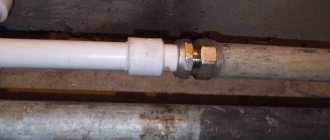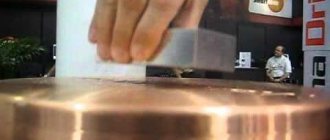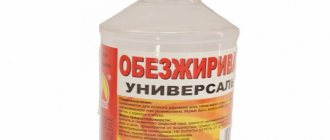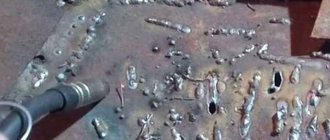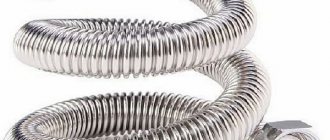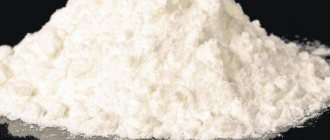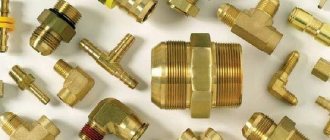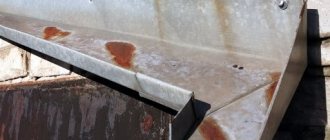- 7 options for switching from HDPE to metal
- Video on how to connect HDPE to steel using quick-release couplings
- Bonus lifehack. We connect the plastic pipe to the metal one using a bottle.
Hello. This article belongs to the category of “frequently asked questions”.
Our customers who successfully use quick-release couplings for plastic pipelines ask the question of how to connect a metal pipe to a plastic one. And also how to attach steel pipeline fittings to a plastic pipe. We'll talk about gate valves in another article, including check valves using our quick-release connections. And in this material we have compiled a selection of the most common methods of connecting metal and plastic pipes.
When is such a connection needed?
The need for connections of this type arises in the following cases:
- connecting to an existing metal (most often cast iron) riser of a polymer liner from a sink, sink, bathtub, etc.;
- installation of steel reinforcement on the HDPE pipeline;
- connection to a system with a high operating temperature, which low-density polyethylene (HDPE) cannot withstand;
- connection to the metal outlet of a garden irrigation system from the house;
- a tie-in into the central highway, the wiring to which passes through an area with increased load. In this place, stronger metal segments are used, and polymer pipes go up to it.
Advantages and disadvantages of such a connection
Preference is given to such a connection due to the unique characteristics and high performance properties of HDPE products. They got their name thanks to the technology of manufacturing polyethylene under low pressure.
Compared to products made from LDPE (high-density polyethylene), HDPE has a higher density and better strength characteristics.
- Like all types of plastic, it is not subject to corrosion and the destructive effects of chemically aggressive substances, and has a smooth surface that allows it to maintain high throughput throughout the entire period of operation.
- It has frost resistance (withstands -50˚) and low thermal conductivity.
- Polyethylene products are lightweight and easy to assemble. They are cheaper than polypropylene pipes and metal-plastic analogues.
- They are used in the water supply system, when laying external water supply to the house, and installing a sewer network.
The disadvantages of HDPE products include intolerance to high temperatures (begins to soften at 80˚). Because of this, it is not recommended for use in heating and hot water supply systems, where it is better to use metal-plastic.
Polyethylene is very susceptible to UV rays, therefore it is recommended only for laying underground, in dark rooms.
This video demonstrates the characteristics of low pressure pipes:
Key features of pipes
HDPE is produced under pressure; it is a special type of polyethylene. It can be obtained after the polymerization of ethylene, a substance of organic origin. This process is carried out under pressure, the indicators of which approach 2 MPa. The material is under the influence of a so-called catalyst. Not only the designation HDPE is practiced, it is also called PVP. The finished product is much stronger than other types of polymers.
Certain types of HDPE are used in the manufacture of boats. They are also used in the construction of various facilities, for example, landfills for working with hazardous substances.
It serves as one of the components of modern body armor. HDPE is characterized by tightness and enviable strength.
Connection methods
The transition is carried out in two ways:
- detachable (through special adapters in the form of threaded couplings, bends, tees);
- one-piece (using either butt welding or through electric fittings that, when current is applied, can melt the welded surfaces, after cooling which a reliable joint is obtained).
Detachable
Classic threaded connection. Turns are cut into the metal with a die, and a transition fitting is screwed onto them, which has an external or internal thread at one end, and a seat for a plastic element at the other. Today's advanced compression fittings require virtually no tools or equipment for assembly.
Docking using flanges. Used when connecting pipeline fittings made of steel that have a flange or the possibility of welding it. For such connections, a polymer bushing with a separately attached flange was invented. It is put on the sleeve, it is welded to the end of the HDPE pipe. Next, its flange is bolted to a similar part of the connecting element.
The photo shows the bushing:
Flange for sleeve:
One-piece
Based on the welding method of joining components. A distinction is made between butt welding, which is used when connecting pipes and fittings of the same diameter and thickness, and welding through polyethylene-steel electrical adapters using special equipment.
When can butt welding be used?
The method under consideration is usually used in cases where the wall thickness exceeds 5 mm. Preparation of material for the start of work is organized within the framework of the following scheme:
- Align the end of the product relative to the axis of the pipe;
- Remove the chamfer using a sharp knife or (this option is more preferable) a special unit - a chamfer remover;
- Total cleaning and degreasing of the end sections.
It is also necessary to ensure that the main and auxiliary areas that will be in contact with each other are aligned with each other. In simple terms, coaxiality involves installing one part into another in such a way that the pipe in the pipe fits tightly and fits 3/4 of the depth of the coupling, these are the requirements of the technology;
After this (if we are talking about a welding joint), put both soldered parts on the “iron”, let it heat up for the time specified in the instructions for the device and connect, checking the tightness after cooling.
Diameter standards
The main dimensional parameter of a HDPE pipe is the outer diameter. In accordance with GOST, it is indicated in the labeling of domestic products. The size range is set in a certain sequence, the most used starts from 16 mm and goes up to 110 mm.
When installing yourself, it is important to understand how to combine sections of pipe products made of steel and HDPE. There is a specially designed table of their sizes suitable for each other:
Step-by-step technique for connecting pipes with your own hands
The technology for converting HDPE to metal includes the following stages:
- choosing a connection method;
- determination of section sizes and material lengths;
- purchase of pipes, fittings;
- tool preparation;
- connection installation;
- verification tests.
- necessary tools and materials
The minimum set of tools includes:
- wrenches, adjustable wrenches;
- mites;
- pipe cutter;
- thread cutter;
- welding machine if necessary.
Materials are purchased depending on the volume of work, pipes - taking into account 10% of losses to waste.
Work progress
- Threaded detachable connections begin with the preparation of the steel end: it is cut, aligned, and threaded.
- Then, using a winder, the adapter fitting is screwed on by hand.
- At the other end of the fitting, plastic is installed using a crimp nut.
- Use a wrench to tighten the fitting onto the thread.
Installation features
Polyethylene fittings are used mainly for joining pipes of small sections.
It is important to note that there are adapters with both internal and external threads. Therefore, they are selected depending on the purpose and, naturally, in accordance with the size of the pipes.
A popular fitting for connections of this type has become the so-called “American” coupling, with a steel end and a thread cut on it on one side, and a plastic outlet on the other.
Just a sawn-off polyethylene pipe hardly fits into the sealing ring. You can cut the outer parts of the pipe into a cone with a knife. The product will go in all the way without any problems.
How to connect a faucet to a HDPE pipe
To install a faucet on a plastic HDPE pipe with your own hands, you need to adhere to a certain action plan that takes into account the technology and rules of work. We will consider the installation option using plastic-to-metal transition fittings. In general, this procedure consists of the following steps:
- selection of the necessary set of tools - it should include a pipe cutter (scissors) to prepare the ends of the pipes for connection, a soldering or welding machine, and keys for installing the faucet itself;
- purchasing fittings of the appropriate types and sizes: for pipes with a vertical outlet these are angles and tees, for pipes with a horizontal outlet, couplings are needed;
- the end of the pipe is cut at a right angle and, if necessary, cleaned of burrs;
- use a soldering iron to heat the connected parts of the pipe and fitting to the required temperature;
- the heated parts are connected without delay and their position is immediately corrected if necessary, which applies to tees and angles; this is not required for couplings;
- a few minutes after soldering the connection, you can install the tap;
- Upon completion of installation, check the tightness and functionality of the tap.
It’s easy to find fairly detailed instructions on the Internet on how to connect a ball valve to a HDPE pipe. However, it is worth noting that the best recommendations for installing taps and other pipeline fittings are given by professionals. Therefore, you should not be misled by the apparent simplicity of this process.
In such work, practical skills that come with experience are especially important. If you do not regularly install pipeline fittings, there is a high risk of errors, which are costly in all senses of the word. Professionals perform many of their actions “on autopilot,” but you don’t have it. Therefore, it would be most reasonable to invite specialists for such work.
Frequent connection problems and errors
Errors when selecting pipes: a product for cold water was used for the heating system or HDPE products were used for pressure water supply. You should pay attention to product labeling. Colored longitudinal stripes indicate areas of product use: blue - for drinking water, yellow - for gas pipelines, no stripe - for technical water supply.
- Use of HDPE pipes for purposes other than their intended purpose
- Use of low-quality fittings.
- Laying pipelines in areas with heavy loads - under roads, etc.
- Improper use of compression fittings. Often the pipe is inserted into the fitting, resting its end against the rubber ring. It is not right. You need to chamfer the end, as if to give it the appearance of a cone, which will allow you to insert the end of the pipe into this ring and push it in deep until it stops. After tightening the nut, the ring will seal, creating a strong connection.
Expert advice
When installing a metal tap on a HDPE pipe, an effective solution may be to use an electric welded saddle. This is especially suitable for installation under pressure. The saddle is welded to the polyethylene using built-in spirals, and then a hole is drilled in the channel to install the tap.
Threading a steel end is essentially the most difficult stage in installation. To make this labor-intensive process more efficient, it is recommended to alternate moving the thread cutter half a turn forward and moving it back a little. This will save energy and speed up work.
Bonus lifehack. We connect the plastic pipe to the metal one using a bottle.
SaveSavedDeleted 0
Previous
GOST 12.2.085-2002. Pressure vessels. Safety valves. Safety requirements
Next
Flange Mounting Chart
Tags: BRSPND pipeDismountable pipe connections
A combination of several pipe joining methods
Special compression adapters combine flange connection and the properties of a compression fitting. At one end they have a regular flange, which is mounted with bolts to the mating flange of the metal pipe, at the other - a compression transition using a crimp nut.
This method is used in networks with small pipes (up to Ø 110 mm).
The photo shows a HDPE compression adapter with a flange:
There are permanent threaded joints in which the thread is used only to fix the segment, and then an additional channel is welded on.
